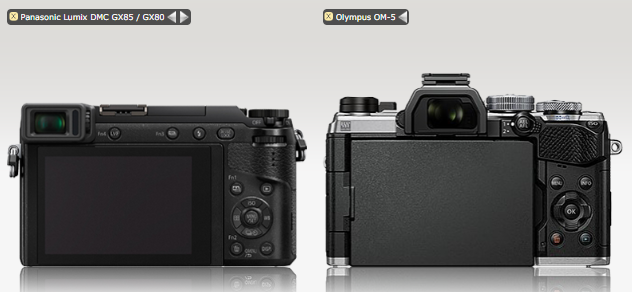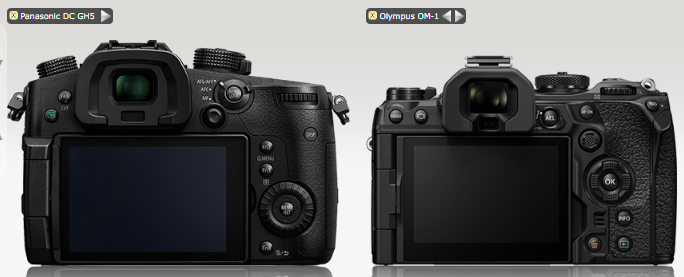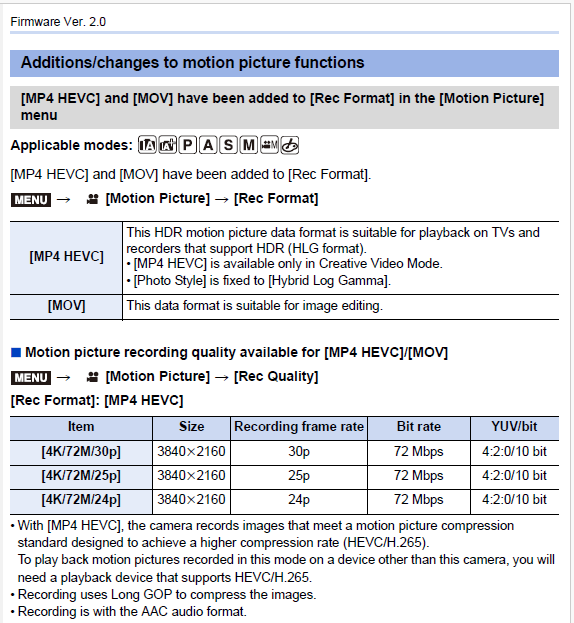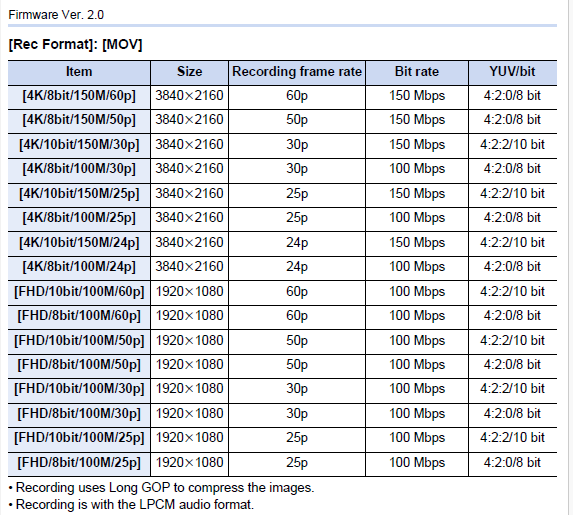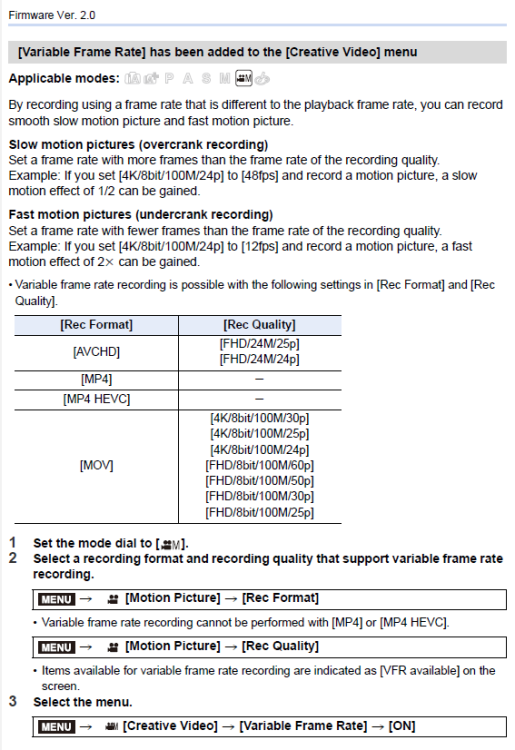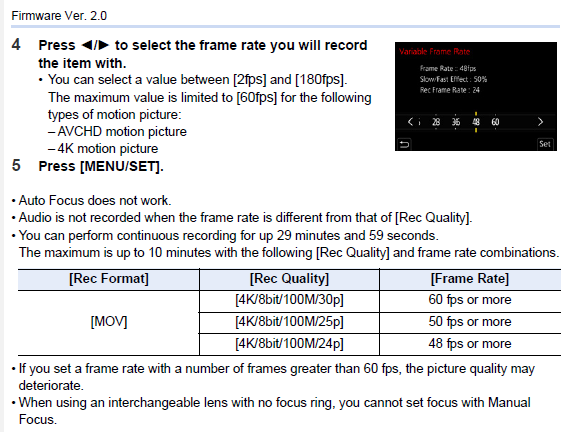
ac6000cw
Members-
Posts
683 -
Joined
-
Last visited
Content Type
Profiles
Forums
Articles
Everything posted by ac6000cw
-
I think it's because Z-mount has the shortest flange to sensor distance of the common mirrorless mounts. So it's possible to make a (2mm thick!) E-mount to Z-mount adaptor e.g. the Megadap one, but not the other way round.
-
It's TicoRAW from IntoPIX - see https://www.dpreview.com/news/9624409613/nikon-is-licensing-intopix-s-ticoraw-technology-for-its-z9-camera-system and https://www.intopix.com/tico-raw
-
I think he was talking about N-RAW versus h265. The bitrates for N-RAW are here - https://onlinemanual.nikonimglib.com/z9/en/06_video_recording_02.html#id226OJ0Y0V5Z - 4.1k at 24 p is 350 Mb/s in Normal quality mode.
-
Capital M = 'mega' = x1000000 Lowercase m = 'milli' = /1000 So megabits per second = Mb/s.
-
Maybe they should introduce Z-mount versions of their (low-end, for RED) RF-mount Komodo cameras, branded 'Nikon RED', 'Z-RED' or 'RED-Z', with maybe switchable color science compatible with either Nikon hybrids like the Z8/Z9 or other RED cameras. That might provide upward and downward paths between RED and Nikon cameras without diluting the RED brand.
-
The Chris & Jordan Peta Pixel review is a bit mixed (especially for video) - poor battery life, some IBIS jerkiness and of course high rolling shutter...
-
I agree - the RED cinema cameras will keep the RED branding - it would be silly to dilute/erase the RED brand image. (pure speculation) From a branding point of view, maybe Nikon might add some subsidiary RED branding to few video-orientated hybids e.g. 'RED Cinema' or 'Video by RED', in the way Panasonic and Sony use the Leica and Zeiss branding on some products?
-
The SL3 is released - https://www.dpreview.com/reviews/leica-sl3-initial-review From the review:
-
IIRC, that included RED being able to use the Canon RF-mount on their cameras - so I guess in theory a Nikon-branded RED camera could have a Canon lens mount on it... but the Canon-RED agreement might not allow that if RED were taken over by another camera company. So are we going to see some Nikon Z-mount cinema/video lenses eventually to go with a RED-designed camera, or is this takeover primarily about REDs IP/patents and high-end video processing knowledge?
-
Those are exactly the issues I have with the FP or FP-L - I like the small form-factor, but a camera without IBIS for video is basically ruled out for me, as I film almost 100% hand-held (and stabilizing in post is sometimes very difficult with the subjects I film, as well as being time-consuming).
-
I've also thought about trying/buying an A6700 a few times for the same reasons... pity it doesn't have a higher-res viewfinder than 2.36M-dot (having a 5.76M-dot EVF in the OM-1 is really nice, as is the 1.62M-dot rear screen)
-
Just added a graded, 8-bit Rec709 version of some of the clips to the folder - 'OMLog400 test graded 8-bit Rec709.mov'
-
Just added a graded, 8-bit Rec709 version of some of the clips to the folder - 'OMLog400 test graded 8-bit Rec709.mov'
-
Here is a collection of 10-bit OMLog400 and HLG files (and a couple of stills) from my OM-1 - https://drive.google.com/drive/folders/1527WMHFXJmDvTGI74QINJQdstgJPhXyt?usp=sharing All are FHD, using shutter priority ay 1/100s (auto-ISO and auto-aperture), auto WB (with the 'keep warm colors' option on) and C-AF set to a medium central area - so pretty much 'point and shoot' video. Lens was Oly 12-40 F2.8 pro. IBIS was sensor shift only, mostly on the maximum stability '+1' setting (which can cause jerky pans - the standard setting is '0').
-
For anyone interested, here is a collection of 10-bit OMLog400 and HLG files (and a couple of stills) from my OM-1 - https://drive.google.com/drive/folders/1527WMHFXJmDvTGI74QINJQdstgJPhXyt?usp=sharing All are FHD, using shutter priority ay 1/100s (auto-ISO and auto-aperture), auto WB (with the 'keep warm colors' option on) and C-AF set to a medium central area - so pretty much 'point and shoot' video. Lens was Oly 12-40 F2.8 pro. IBIS was sensor shift only, mostly on the maximum stability '+1' setting.
-
This is a good technical review (with some downloadable video samples) of the video side of the OM-1 - https://www.optyczne.pl/59.1-Inne_testy-OM_System_OM-1_-_test_trybu_filmowego_Wstęp.html
-
To add to what John has said, currently the best small (ish) Olympus/OM System camera is the OM-5 - that's basically the guts of an E-M1 iii in a smaller/lighter body (about the size of the GX85 if you ignore the viewfinder hump). I don't own one, but do own the E-M1 iii, so based on that: 8-bit video only, FHD is soft, UHD is OK, C4K is very good but is 24p only, video C-AF is good (uses PDAF), IBIS is excellent. The OM-1 is larger and rather more expensive, but smaller and lighter than the GH5. 10-bit 4:2:0 video is H265 Rec2020 in HLG and OMLog400 only, 8-bit video is H264 Rec709 in Flat, OMLog400 and any of the 'photo' profiles. 10-bit video modes are more detailed/higher resolution than equivalent 8-bit video modes - so for best quality go for 10-bit UHD/C4K in 24p/25p/30p (UHD/C4K 50p/60p is a bit softer, 10-bit FHD is rather better than 8-bit on E-M1 iii/OM-5). So far I've been quite pleased with the usable dynamic range on the OM-1 in 10-bit HLG and OMLog400 - the new sensor and 10-bit processing path is definitively a significant upgrade from the older E-M1 iii.
-
I bought a used OM-1 a while ago, and it's slowly turned into my favoured camera for video since then (despite some of its annoyances). I think part of the reason for that is because it has a very fast readout stacked sensor, with rolling shutter time around 5-7 ms in FHD & UHD, which seems to give a 'solidity' to the video combined with fluid motion handling (I normally shoot at 50p), compared to my G9 with about 12-15 ms rolling shutter. If my liking of the OM-1 video is due to low rolling shutter then maybe I'm subconsciously sensitive to the picture distortions created by rolling shutter (including interactions with the IBIS behaviour). But then I'm often filming subjects like trains which readily show up rolling shutter distortions, so maybe that's sensitised me to it?
-
After owning a variety of consumer/prosumer camcorders (starting with VHS-C in 1995, then several DV then HDV), I skipped DVD-based ones and decided that the memory-card based ones (that I could afford) were getting too small and light to hand-hold with reasonable stability. Also viewfinders were becoming rare other than on the higher-end camcorders. Having noticed that reasonable video was starting to appear as a feature in 'photo' cameras, I tried a Pana TZ7/ZS3 compact, then a Sony HX9V compact and Pana FZ100 superzoom. Decided that I preferred the form-factor/handling so moved on to a Pana G3 MILC - nice and compact, good to hold, with a decent viewfinder, video, audio and stills. Upgraded after a while to a G6 with 14-140mm lens (probably my all-time favourite lens) - much larger sensor than any consumer camcorder but still a fairly compact setup for something with a 10:1 zoom lens. As I'm very much a hybrid shooter, I prefer the m43 'compact MILC' form-factor (and the IBIS). The only 'icing on the cake' that I'd like is a quality power-zoom lens with a decent range - the (now obsolete) Oly 12-50 is about as close as m43 has ever got to that. So no, I wouldn't buy a 'camcorder' form-factor camera again. (When I look at some of my old VHS-C or DV footage, it just reminds me of how far consumer/prosumer video capture has improved over time...from less-than-SD resolution, interlaced, noisy, smudgy video to pristine 50p/60p UHD from a pocket-sized camera - wow!)
-
The Metabones micro43-EF Speedbooster product pages have info on certain types/models of manual focus lenses which are not compatible due to having rear protrusions which could damage the Speedbooster e.g.: General m43-EF Speedboosters: https://www.metabones.com/products/details/MB_SPEF-m43-BT3 https://www.metabones.com/products/details/MB_SPEF-M43-BT4 BM-only m43-EF Speedboosters: https://www.metabones.com/products/details/MB_SPEF-m43-BT8 https://www.metabones.com/products/details/MB_SPEF-M43-BT9 (scroll down to the 'Manual Focus Lens Compatibility' section near the bottom of the page) Yashica is not on the list.
-
One of the most common audio plugin formats.
-
The G9 not only supports 10-bit video, it also supports 4:2:2 - below are the extra video modes added in the major FW 2.0 upgrade (plus variable frame rate recording, HLG support and adjustable video levels). MF linear focus control (with lenses that support it), 'red frame' record indication and vertical video support were added in later FW updates. Note it doesn't support DCI 4k or All-I compression (it's max 100Mbps for FHD, 150Mbps for 4k, long-GOP). All of that puts the G9 way ahead of the E-M1 ii for video quality and flexibility (but the E-M1 ii/iii and OM-1 are a bit smaller and better ergonomically, IMHO).
-
I'm definitely not convinced (to upgrade as an OM-1 owner) - I think it's too expensive at the launch price of £2200 in the UK, especially now the £1700 G9 ii is around. And as for that very large & heavy (for micro43) 150-600mm lens that's only F5 max aperture and costs £2500...what are they thinking - have they forgotten what micro43 is supposed to be about?
-
As far as I've found out to date, video related improvements are limited to support for vertical-format video and improved AF performance (inherited from the photo side, I assume). It also now directly supports being used as a USB webcam. I hope they might port the Mk 2 feature of allowing the 'menu' button to be re-assigned the 'trashcan' button in a firmware update for the original OM-1 (so that you can access and operate the menu system entirely with your right hand). This is a live intro and Q & A session I watched from yesterday, presented by David Smith from OMDS UK (who I've met a few times at open days/exhibitions and seems a very knowledgeable guy), which covered the basic changes and answered some questions (the video-related section starts around 46:23):
-
Yes (as the main audio - I'm just using it for amateur outdoor documentary stuff). It's the 32-bit float that is the attraction, as it makes audio input level adjustment on the recorder something else I don't have to worry about. Same reason I normally use shutter-priority auto exposure for video - it leaves me free to concentrate on framing and holding the camera still (or moving it smoothly). Yes - I want stereo ambient sound but the VP83F is mono super-cardioid (and somewhat larger in size). I prefer a 90 degree X-Y cardioid stereo configuration, as that gives me the sound-stage width I prefer. I often use a Tascam TM2X stereo on-camera mic (without the extension arm!) as the size versus quality balance of that works for me. I've tried others over the years (both mics and recorders) but that's the one I keep coming back to. What would be really nice is a mirrorless ILC camera with 32-bit float audio support...



